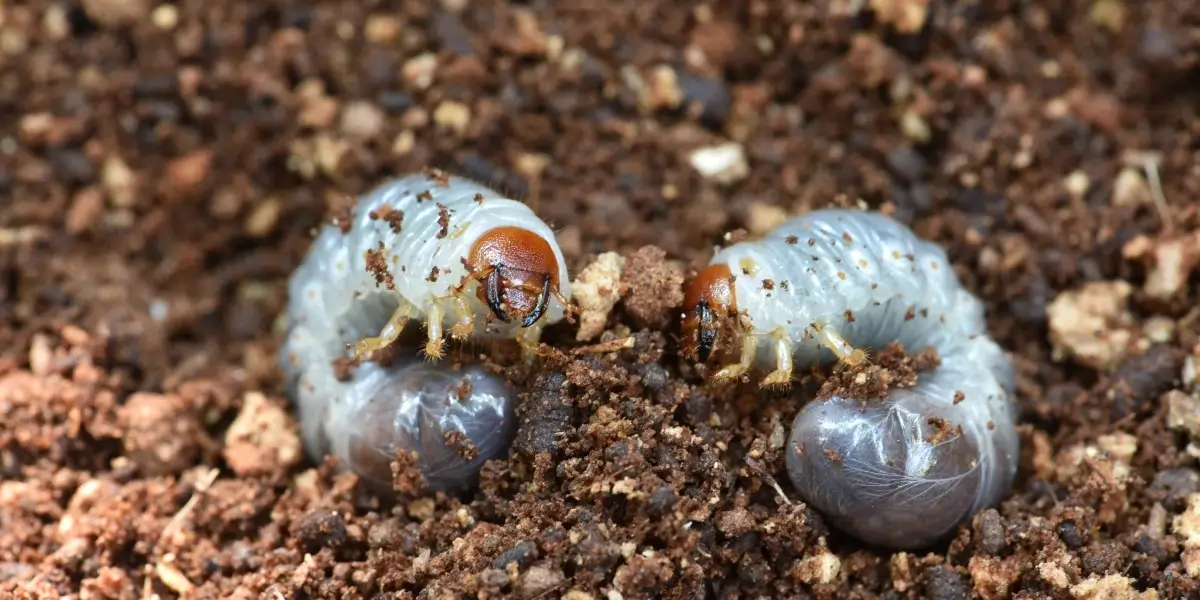Grubs are one of the most common—and most destructive—lawn pests we deal with at Luigi’s Landscaping. These small, white larvae feed on the roots of your grass, leaving behind patches of dead, spongy turf. If you’ve noticed brown spots or loose grass that lifts easily from the soil, you may be facing a grub infestation.
Understanding how grubs behave, when they appear, and how to get rid of them can help you restore your lawn and prevent future damage. As lawn care professionals, we’re here to walk you through every step.
What Are Grubs and Their Life Cycle?
Grubs are the larvae of various beetles, including Japanese beetles, June bugs, and chafer beetles. They hatch from eggs laid in the soil and feed on grass roots, typically during late summer and early fall.
Grub life cycle:
- Spring: Adult beetles lay eggs.
- Summer: Eggs hatch, larvae begin feeding.
- Fall: Larvae go deeper into the soil to overwinter.
- Next Spring: They pupate and emerge as beetles.
Timing your treatment to this cycle makes a big difference in effectiveness.
How to Identify a Grub Problem
Grubs often go unnoticed until the damage is visible. The most common signs include:
- Brown or thinning patches of grass that worsen despite regular watering.
- Turf that lifts easily from the soil, almost like a loose carpet.
- A spike in birds, raccoons, or skunks digging in the lawn to feed on grubs.
To confirm, you can peel back a small section of turf. Finding more than five grubs in a square foot of soil usually signals the need for treatment.
When to Treat for Grubs
Choosing the right time to treat your lawn makes all the difference. For prevention, applying treatment before beetle eggs hatch in early summer is most effective.
If you’re already seeing damage in late summer or early fall, you’ll need a curative treatment that targets active grubs feeding just below the surface.
Treating outside of these windows, especially during winter or early spring, won’t have much effect, as grubs are inactive and deeper in the soil.
Transform Your Outdoor Space with Luigi’s Landscaping
From lush lawns to stunning garden designs, we bring your landscaping vision to life—reliably, professionally, and with care for every detail.
Get Your Free Quote
How to Get Rid of Grubs: Safely and Effectively
There are two main approaches to grub control: natural and chemical. The best solution depends on your lawn’s condition, your timeline, and whether pets or children use the space.
Natural and Pet-Safe Methods
If you’re looking for a non-toxic solution, several natural methods work well without harming pets or beneficial insects.
Beneficial nematodes are tiny worms that seek out and destroy grubs in the soil. They’re completely safe for kids, pets, and the environment. Another natural option is neem oil, which interferes with grub development and feeding.
For longer-term protection, milky spore builds up in the soil and specifically targets Japanese beetle larvae, although it may take multiple seasons to reach full strength.
Chemical Treatments
For severe infestations or faster results, chemical treatments can be effective. Preventative products containing imidacloprid or chlorantraniliprole are best applied before the eggs hatch.
These products remain in the soil and kill grubs as they emerge. For active infestations, curative treatments with ingredients like carbaryl or trichlorfon are ideal during late summer and early fall when grubs are feeding near the surface.
If you’re using chemicals, make sure to water them in thoroughly and keep pets and children off the treated area until it’s dry.
Can You Get Rid of Grubs Fast?
Yes, if you catch the infestation early. Fast-acting curative products can start working within days. Natural methods like nematodes may take a little longer, but offer long-term benefits with no risk to your family or pets. Whichever route you choose, combining treatment with proper lawn care will always yield better, longer-lasting results.
Preventing Grubs in the Future
A healthy, well-maintained lawn is your best defense against grubs. Keeping your grass mowed at the right height (around 3–4 inches), watering deeply but less often, and aerating in the fall helps prevent compaction and improves root health. Avoid over-fertilizing during beetle season, as lush growth can attract adult beetles looking to lay eggs.
Routine monitoring, especially in late summer, ensures you catch any issues early before they turn into larger problems.
Get Help from the Experts at Luigi’s Landscaping
Whether you’re dealing with your first grub problem or facing repeated infestations, we’re here to help. At Luigi’s Landscaping, we offer both eco-friendly and traditional treatments tailored to your lawn’s needs. With our years of experience, we can quickly assess the severity of your issue and provide a plan to restore your lawn’s health.
Contact us today for a lawn inspection or grub treatment consultation. Let us help you protect your lawn from the ground up—safely, professionally, and with lasting results.

